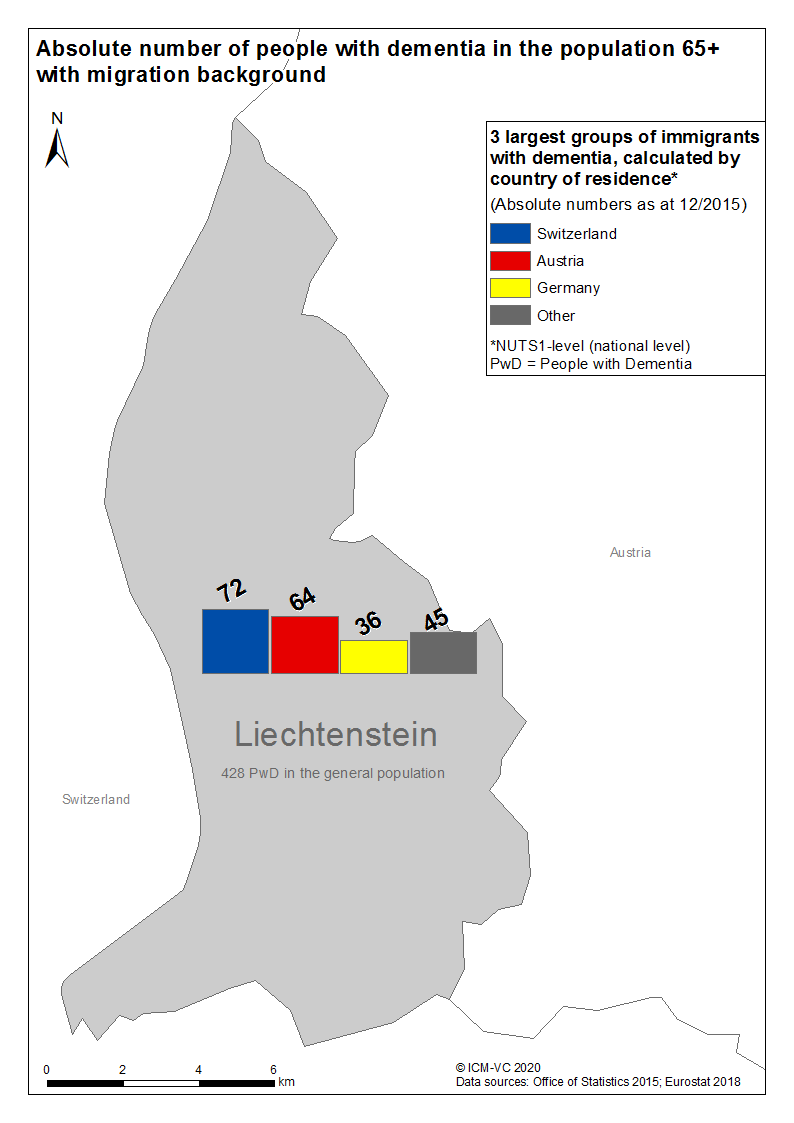EU-Atlas: Dementia & Migration
| Largest group | 2. largest group | 3. largest group | 4. largest group | 5. largest group | |
| Absolute numbers | |||||
| PwMD per 100,000 inhabitants 65+ |
| Absolute numbers | PwMD per 100,000 inhabitants 65+ | |
| Largest group | ||
| 2. largest group | ||
| 3. largest group | ||
| 4. largest group | ||
| 5. largest group |
| Prevalence per 100,000 inhabitants 65+*, calculated by country of residence | |||
|---|---|---|---|
| high > PwMD |
minor > - PwMD |
||
| increased > - PwMD |
low ≤ PwMD | ||
| medium > - PwMD |
|||
| PwMD = People with a Migration background with Dementia *Bulgarien, Litauen, Malta, Polen in der Bevölkerung 60+ |
|||
| Absolute number of PwMD 65+ | |
| PwMD per 100,000 inhabitants 65+ |
Liechtenstein
Within the last century, Liechtenstein has developed from an emigration country to an immigration country due to industrialization, an economic boom and political, social, territorial, and economic changes1,2. Between 1990 and 2019, the migrant population (born abroad) more than doubled (10,900 to 25,500). At the same time, the proportion of migrants in the total population has risen from 38 to 67%3. The great importance of migration in Liechtenstein is due to the economic position of the country, the globally operating companies, the high number of employees, especially migrants, and the multinational identities of many citizens among other reasons. In quantitative terms, family reunification of migrants and marriage migration plays the most important role in immigration2.
There are 3,100 people with a migration background aged 65 or older. Of those, approx. 200 exhibit some form of dementia. The most affected migrant groups presumably originate from Switzerland (approx. 70), Austria (approx. 60) and Germany (approx. 40)4.
The ‘Dementia Strategy for the Principality of Liechtenstein’ from 2012 has a length of 36 pages. This document is divided into four chapters: overview of dementia, health and social policy significance of dementia, current situation in Liechtenstein, goals of the Dementia Strategy 2020. None of these topics is set in a migration context5. According to an expert in dementia care, there are no treatment or care guidelines for dementia at the national level.
An integrative model is used to care for migrants with dementia. Dementia-specific information and healthcare services are nationwide available. This in principle also applies to migrants. However, there are no care services specifically tailored to the needs of people with a migration background with dementia and the information is only available in German. Due to a relatively high proportion of migrants in the nursing profession and a high diversity with regard to the countries of origin of the nursing staff, linguistic and cultural competences are basically available, but they are currently not systematically applied or used for the development of specialised care services for people with a migration background. Still, existing care services in Liechtenstein seem to be suitable for people with dementia with and without a migration background.
Culturally sensitive issues are part of the education and training of caregivers, but there is still a lack of professional training opportunities for healthcare professionals in culturally sensitive or intercultural care. The proportion of professional caregivers with a migration background in inpatient care is approximately 60%. The need for culturally sensitive care (either in outpatient or in inpatient care) is not met by sufficiently qualified professionals.
The importance of families in the support of family caregivers of migrants with dementia is very high and care providers as well as migrant organizations play a significant role, too. The need for specialized services providing support and information to these family caregivers is high. Currently, there is still a lack of tailored, native-language information resources for caregivers of migrants with dementia.
References
- Marxer W: Migration und Integration: Geschichte – Probleme – Perspektiven In: Studie zuhanden der NGO-Arbeitsgruppe „Integration“. Liechtenstein-Institut; 2007.
- Marxer W: Migration: Fakten und Analysen zu Liechtenstein. In.: Liechtenstein-Institut; 2012.
- International Organisation for Migration: International migrant stock as a percentage of the total population at mid-year 2019: Liechtenstein; 2019.
- Office of Statistics: Volkszählung. In. Vaduz: Office of Statistics; 2015.
- Regierung des Fürstentums Liechtenstein: Demenzstrategie für das Fürstentum Liechtenstein. In. Edited by Ressort Soziales und Gesundheit; 2012.


![[Translate to Englisch:] Logo RBS [Translate to Englisch:] Logo RBS](/fileadmin/_processed_/9/7/csm_RBS_Logo_RGB_0e245a98a4.jpeg)